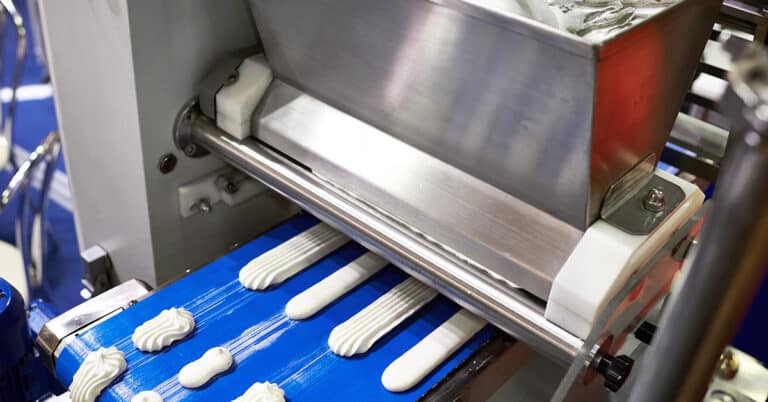The term “smart factory” is becoming more and more common, usually in conjunction with Industry 4.0, but it isn’t always exactly clear to what it is referring. In this piece, we’ll explain what the smart factory is and share steps on how to start on the path to one — so you can take advantage of the benefits that smart factory technology can offer.
In a smart factory, essential equipment is connected through a central network. This enables machines to communicate with each other and operators to monitor their performance. When integrated with advanced software including artificial intelligence and machine learning algorithms, many industrial processes can be automated in such a way that machinery can adjust to changes automatically. Many associate the concept of the smart factory with Industry 4.0, which refers to the transformation of the industrial sector through intelligent automation and the Industrial Internet of Things.
Smart factory technologies & IoT
- Industrial IoT: The Industrial Internet of Things (IIoT) connects smart equipment through a network of sensors and advanced software. Machines share information with each other and operators, with the system providing analytics that drive decisions about preventive maintenance, root cause analysis and more.
- Sensors: The backbone of most smart factory IoT installations, machine monitoring sensors provide a wide range of data to networks and operators. These devices track indicators including temperature, pressure, current, humidity, vibration and more, delivering up-to-the-minute information to enable people and software to make better-informed choices.
- Artificial intelligence: The rise of artificial intelligence has transformed the way many factories operate, enabling faster and more accurate decisions and allowing human workers to focus their attentions elsewhere. In particular, the use of AI in predictive maintenance predicts potential issues with equipment before they arise through machine learning and predictive algorithms.
- Virtual reality (VR) and augmented reality (AR): Far from creating a fantasy world, these immersive technologies are helping industrial workers focus on what’s right in front of them. For example, the use of virtual reality in manufacturing allows technicians to inspect a 3-D model of a piece of equipment without needing to take the real machine offline. Wearable technology feeds maintenance and repair personnel detailed information about the components they work on without needing to stop what they’re doing to refer to a service manual.
- Digital twins: Prototyping has taken a huge leap forward thanks to the introduction of digital twins. These duplicate the form and function of a product or component in a virtual environment, enabling engineers to test and tweak them without necessarily creating a physical version of each iteration.
- Cloud computing and connectivity: There exists a variation of cloud computing known as fog computing that has become a major element of smart factories. Simply put, this refers to connections between the sensors, actuators and other devices that deliver data that are more local than what is typically considered the cloud. Being closer to “the ground,” these connections provide more agility and security than traditional cloud computing solutions.
- Advanced analytics: Another key element of the smart factory is driven by analytics software. By analyzing the data collected through sensors and other connected devices, these platforms identify trends and make recommendations for preventive maintenance and more. Predictive maintenance analytics can save factories a significant amount of time and money by preventing unexpected downtime and streamlining processes.
Smart factory benefits
Smart factory technology can yield numerous benefits, and they start as soon as you begin implementation. These benefits include:
- More educated maintenance: In smart factories, predictive maintenance is the norm, rather than preventive maintenance. With predictive maintenance, impending maintenance needs are identified and addressed well before they become production issues. Over time, this technology allows for maintenance to become a much more valuable and efficient process.
- More uptime: Better maintenance means fewer unscheduled downtime events, and allows for more targeted, productive downtime when it is necessary. With more uptime for your equipment, you increase the return on both your equipment and your smart factory technology investments through higher production yields.
- Increased production efficiency: Smart factories enable real-time monitoring and adjustments at the finest levels, ensuring that quality is more consistent thanks to equipment that now operates at peak performance more often.
Step-by-step guide to building your smart factory
- Identify your needs and goals: It isn’t enough to simply decide that you want to implement a smart factory and go from there. As with any equipment or technology investment, the “why” is critical to making sure that you’re investing in the right areas. Most smart factory implementations occur in phases. It’s important to identify your priorities so that you are investing in the right equipment at the right time. Aiming to quickly boost your maintenance efficiency will require different technology than increasing production.
- Get your personnel on board: More technology and automation can be intimidating to workers, who may fear that they will lack the skills or knowledge needed to work with new technology. By explaining the reasons for the shift to smart factory technology, soliciting feedback, and training employees on these new processes, you can be sure that your most valuable resource – your employees – will continue to grow and improve with you.
- Be aware of security: With newly connected devices, cybersecurity becomes a concern. Don’t overlook this important aspect of the smart factory and take appropriate precautions to ensure your value able data is protected.
- Make the new equipment investment: Sensors and monitors play a key part in enabling the smart factory and will likely be a new purchase requirement for you to get up and running. You may also need infrastructure upgrades (such as increased Internet and Wi-Fi bandwidth), as well as computer equipment to store, analyze and manage the large amounts of data that will be collected.
- Make the personnel investment: You may need to invest in data analysts to turn the data collected into something usable and valuable. This is also an area where training or lateral movement from your existing personnel can be an option. This is also an area where outsourcing expert technical talent is an option.
- Outfit your equipment and begin collecting data: Smart sensors can almost always be used with your existing equipment, so once you have the new technology you need, you’re ready to start using it.
- Analyze and use the data: The real-time aspect of the data collected is one of the most useful aspects of the smart factory — enabling in-process adjustments and changes, as well as much earlier notice of maintenance requirements. Be sure to take advantage of this benefit, rather than using data after the fact — which will still yield benefits, but not to the extent that is possible.
- Continue to upgrade your smart factory implementation: As you and your staff grow more familiar with smart technology and its benefits, it will become easier to continue to expand the smart technology to other areas of your facility.
Making the transition to smart factory technology
Transitioning to a smart factory can be a complex, time-consuming process, even when done in small steps. There are myriad companies with extensive expertise in smart technology, though not as many that focus on manufacturing and industry. ATS is one of these companies, with over three decades of maintenance and factory solutions expertise that include the implementation and management of your smart factory and smart manufacturing processes. To discuss your needs, contact us today.






